| Listing 1 - 10 of 16 | << page >> |
Sort by
|
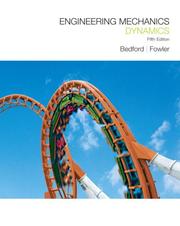
ISBN: 9780136129165 Year: 2008 Publisher: Upper Saddle River, N.J. Pearson
Abstract | Keywords | Export | Availability | Bookmark
 Loading...
Loading...Choose an application
- Reference Manager
- EndNote
- RefWorks (Direct export to RefWorks)
mechanica --- Applied physical engineering --- dynamica --- Classical mechanics. Field theory
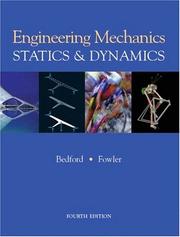
ISBN: 0131463292 Year: 2005 Publisher: New Jersey Pearson
Abstract | Keywords | Export | Availability | Bookmark
 Loading...
Loading...Choose an application
- Reference Manager
- EndNote
- RefWorks (Direct export to RefWorks)
Mechanica --- Mechanica : dynamica --- Mechanica : kinematica --- Mechanica : statica --- 531 --- Dynamics. --- Mechanics, Applied. --- Statics. --- Dynamics --- Mechanics, Applied --- Statics --- Applied mechanics --- Engineering, Mechanical --- Dynamical systems --- Kinetics --- Engineering --- Mathematics --- Mechanics --- Mechanics, Analytic --- Physics --- Equilibrium --- Engineering mathematics --- Force and energy
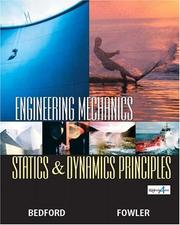
ISBN: 0130082090 Year: 2003 Publisher: Upper Saddle River Prentice Hall
Abstract | Keywords | Export | Availability | Bookmark
 Loading...
Loading...Choose an application
- Reference Manager
- EndNote
- RefWorks (Direct export to RefWorks)
Dynamics --- Mechanics, Applied --- Statics
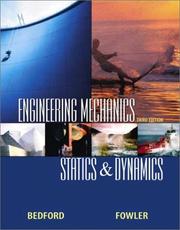
ISBN: 0130324736 Year: 2002 Publisher: Englewood Cliffs Prentice-Hall
Abstract | Keywords | Export | Availability | Bookmark
 Loading...
Loading...Choose an application
- Reference Manager
- EndNote
- RefWorks (Direct export to RefWorks)
Dynamics --- Mechanics, Applied --- Statics
Book
ISBN: 9789810679392 9810679394 9789810679415 Year: 2008 Publisher: Upper Saddle River Prentice Hall
Abstract | Keywords | Export | Availability | Bookmark
 Loading...
Loading...Choose an application
- Reference Manager
- EndNote
- RefWorks (Direct export to RefWorks)
Mechanics, Applied --- Statics --- Dynamics
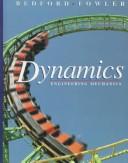
ISBN: 0201581973 9780201581973 Year: 1995 Publisher: Reading (Mass.): Addison-Wesley,
Abstract | Keywords | Export | Availability | Bookmark
 Loading...
Loading...Choose an application
- Reference Manager
- EndNote
- RefWorks (Direct export to RefWorks)
Dynamics --- 531.1 --- 531.3 --- Dynamical systems --- Kinetics --- Mathematics --- Mechanics, Analytic --- Force and energy --- Mechanics --- Physics --- Statics --- Kinematics. Mathematical-mechanical geometry of motion --- Dynamics. Kinetics --- 531.3 Dynamics. Kinetics --- 531.1 Kinematics. Mathematical-mechanical geometry of motion --- Classical mechanics. Field theory --- 531/533 --- Dynamica --- Mechanica
Book
ISBN: 3030220826 3030220818 Year: 2020 Publisher: Cham : Springer International Publishing : Imprint: Springer,
Abstract | Keywords | Export | Availability | Bookmark
 Loading...
Loading...Choose an application
- Reference Manager
- EndNote
- RefWorks (Direct export to RefWorks)
This revised and updated second edition is designed for the first course in mechanics of materials in mechanical, civil and aerospace engineering, engineering mechanics, and general engineering curricula. It provides a review of statics, covering the topics needed to begin the study of mechanics of materials including free-body diagrams, equilibrium, trusses, frames, centroids, and distributed loads. It presents the foundations and applications of mechanics of materials with emphasis on visual analysis, using sequences of figures to explain concepts and giving detailed explanations of the proper use of free-body diagrams. The Cauchy tetrahedron argument is included, which allows determination of the normal and shear stresses on an arbitrary plane for a general state of stress. An optional chapter discusses failure and modern fracture theory, including stress intensity factors and crack growth. Thoroughly classroom tested and enhanced by student and instructor feedback, the book adopts a uniform and systematic approach to problem solving through its strategy, solution, and discussion format in examples. Motivating applications from the various engineering fields, as well as end of chapter problems, are presented throughout the book. Continues emphasis on design including dedicated sections in the chapters on axially-loaded bars, torsion, and stresses in beams, and adds new sections on shear stresses in built-up beams, the moment-area method, and the application of singularity functions; Reinforces concepts with problems following each section and over 1000 figures and tables; Promotes students’ understanding the concept of isotropy in a revised section on stress-strain relations; Emphasizes the importance of visual analysis, particularly through the correct use of free-body diagrams.
Mechanics. --- Mechanics, Applied. --- Materials science. --- Fluid mechanics. --- Solid Mechanics. --- Characterization and Evaluation of Materials. --- Engineering Fluid Dynamics. --- Classical Mechanics. --- Hydromechanics --- Continuum mechanics --- Material science --- Physical sciences --- Applied mechanics --- Engineering, Mechanical --- Engineering mathematics --- Classical mechanics --- Newtonian mechanics --- Physics --- Dynamics --- Quantum theory --- Strength of materials. --- Structural analysis (Engineering) --- Architectural engineering --- Engineering, Architectural --- Structural mechanics --- Structures, Theory of --- Structural engineering --- Materials, Strength of --- Resistance of materials --- Building materials --- Flexure --- Mechanics --- Testing --- Elasticity --- Graphic statics --- Strains and stresses
Book
ISBN: 3031328752 3031328744 Year: 2023 Publisher: Cham : Springer Nature Switzerland : Imprint: Springer,
Abstract | Keywords | Export | Availability | Bookmark
 Loading...
Loading...Choose an application
- Reference Manager
- EndNote
- RefWorks (Direct export to RefWorks)
This revised and updated edition expands on its explanations of methods used to analyze waves in solid materials, such as the waves created by earthquakes and the ultrasonic waves used to detect flaws in materials and for medical diagnoses. In addition to the traditional methods used to analyze steady-state and transient waves in elastic materials, the book contains introductions to advanced areas that no other single text covers. These topics include the use of finite elements to solve wave problems, the Cagniard-de Hoop method, the four-pole technique for analyzing waves in layered media, and the growth and decay of shock and acceleration waves. The authors explain the theory of linear elasticity through the displacement equations of motion, methods used to analyze steady-state and transient waves in layered media, and include an appendix on functions of a complex variable. Originally developed for a graduate course for which no suitable text existed, the new edition retains its classroom-tested treatment of the theories of linear elasticity and complex variables for students needing background in those subjects. Discusses the traditional methods used to analyze steady-state and transient waves in linear elastic materials; Introduces advanced topics such as the four-pole solution for layered media and waves in nonlinear elastic materials; Includes many exercises with solutions.
Mechanics, Applied. --- Solids. --- Plasma waves. --- Geotechnical engineering. --- Statics. --- Dynamics. --- Nonlinear theories. --- Engineering Mechanics. --- Solid Mechanics. --- Waves, instabilities and nonlinear plasma dynamics. --- Geotechnical Engineering and Applied Earth Sciences. --- Mechanical Statics and Structures. --- Applied Dynamical Systems.
Multi
ISBN: 9783030903060 9783030903077 9783030903084 9783030903053 Year: 2021 Publisher: Cham Springer International Publishing :Imprint: Springer
Abstract | Keywords | Export | Availability | Bookmark
 Loading...
Loading...Choose an application
- Reference Manager
- EndNote
- RefWorks (Direct export to RefWorks)
This revised, updated edition provides a comprehensive and rigorous description of the application of Hamilton's principle to continuous media. To introduce terminology and initial concepts, it begins with what is called the first problem of the calculus of variations. For both historical and pedagogical reasons, it first discusses the application of the principle to systems of particles, including conservative and non-conservative systems and systems with constraints. The foundations of mechanics of continua are introduced in the context of inner product spaces. With this basis, the application of Hamilton's principle to the classical theories of fluid and solid mechanics are covered. Then recent developments are described, including materials with microstructure, mixtures, and continua with singular surfaces. Presents a comprehensive, rigorous description of the application of Hamilton's principle to continuous media; Includes recent applications of the principle to continua with microstructure, mixtures, and media with surfaces of discontinuity; Discusses foundations of continuum mechanics and variational methods therein in the context of linear vector spaces.
Algebra --- Functional analysis --- Numerical methods of optimisation --- Operational research. Game theory --- Mathematical physics --- Classical mechanics. Field theory --- Fluid mechanics --- Physics --- Applied physical engineering --- algebra --- analyse (wiskunde) --- toegepaste mechanica --- wiskunde --- fysica --- kansrekening --- mechanica --- optimalisatie
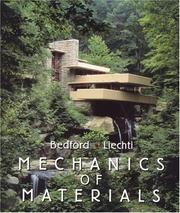
ISBN: 0201895528 Year: 2000 Publisher: Upper Saddle River Prentice Hall
Abstract | Keywords | Export | Availability | Bookmark
 Loading...
Loading...Choose an application
- Reference Manager
- EndNote
- RefWorks (Direct export to RefWorks)
Mechanical properties of solids --- Materials sciences --- Building design --- Building materials. Building technology --- belastingen (technologie) --- materiaalkennis --- sterkteleer
| Listing 1 - 10 of 16 | << page >> |
Sort by
|

 Search
Search Feedback
Feedback About UniCat
About UniCat  Help
Help News
News